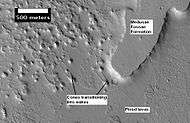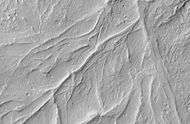Medusae Fossae Formation
 Medusae Fossae based on THEMIS day-time image | |
| Coordinates | 3°12′S 163°00′W / 3.2°S 163.0°WCoordinates: 3°12′S 163°00′W / 3.2°S 163.0°W |
|---|---|
| Length | 333.0 km |
The Medusae Fossae Formation is a large geological unit of uncertain origin on the planet Mars.[1] It is named for the Medusa of Greek mythology. "Fossae" is Latin for "trenches". Located roughly at 5°S 213°E / 5°S 213°E, it straddles the highland - lowland boundary near the Tharsis and Elysium volcanic areas. The Medusae Fossae Formation lies partly in five quadrangles: the Amazonis quadrangle, the Tharsis quadrangle, the Memnonia quadrangle, the Elysium quadrangle, and the Aeolis quadrangle.
The Medusae Fossae Formation is a soft, easily eroded deposit that extends for nearly 1,000 km along the equator of Mars. Sometimes, the formation appears as a smooth and gently undulating surface, however in places it is wind-sculpted into ridges and grooves.[1] Radar imaging has suggested that the region may contain either extremely porous rock (for example volcanic ash) or deep layers of glacier-like ice deposits amounting to about the same quantity as is stored in Mars' south polar cap.[2][3][4] Using a global climate model, a group of researchers headed by Laura Kerber found that the Medusae Fossae Formation could have been formed from ash from the volcanoes Apollinaris Mons, Arsia Mons, and possibly Pavonis Mons.[5] Further evidence for a fine-grained composition is the fact that the area gives almost no radar return. For this reason it has been called a "stealth" region.[6] The formation is divided into three subunits (members) that are all considered to be of Amazonian age, the youngest era in martian geological history.[7]
 Plateau made up of Medusae Fossae materials and rootless cones, as seen by HiRISE. Rootless cones are caused by lava interacting with water ice. Wakes are caused by lava flowing over a source of steam.
Plateau made up of Medusae Fossae materials and rootless cones, as seen by HiRISE. Rootless cones are caused by lava interacting with water ice. Wakes are caused by lava flowing over a source of steam. Mounds with layers, as seen by HiRISE under HiWish program Location is East of Gale Crater in the Aeolis quadrangle.
Mounds with layers, as seen by HiRISE under HiWish program Location is East of Gale Crater in the Aeolis quadrangle. Layers and mounds in Medusae Fossae Formation, as seen by HiRISE under HiWish program Location is East of Gale Crater in the Aeolis quadrangle.
Layers and mounds in Medusae Fossae Formation, as seen by HiRISE under HiWish program Location is East of Gale Crater in the Aeolis quadrangle. Layers and a field of small mounds Medusae Fossae Formation, as seen by HiRISE under HiWish program Location is East of Gale Crater in the Aeolis quadrangle.
Layers and a field of small mounds Medusae Fossae Formation, as seen by HiRISE under HiWish program Location is East of Gale Crater in the Aeolis quadrangle. Mound showing layers at the base, as seen by HiRISE under HiWish program Location is East of Gale Crater in the Aeolis quadrangle.
Mound showing layers at the base, as seen by HiRISE under HiWish program Location is East of Gale Crater in the Aeolis quadrangle. Layers in lower member of Medusae Fossae Formation, as seen by HiRISE. Location is East of Gale Crater in the Aeolis quadrangle.
Layers in lower member of Medusae Fossae Formation, as seen by HiRISE. Location is East of Gale Crater in the Aeolis quadrangle. Surface features along a scarp in Medusae Fossae formation, as seen by HiRISE under HiWish program Location is Memnonia quadrangle.
Surface features along a scarp in Medusae Fossae formation, as seen by HiRISE under HiWish program Location is Memnonia quadrangle.
Inverted relief
The lower portion (member) of Medusae Fossae Formation contains many patterns and shapes that are thought to be the remains of streams. It is believed that streams formed valleys that were filled and became resistant to erosion by cementation of minerals or by the gathering of a coarse covering layer to form an inverted relief. These inverted stream beds are sometimes called sinuous ridges or raised curvilinear features. They have been divided into six classes: flat-crested, narrow-crested, round-crested, branching, non-branching, and multilevel. They may be a kilometer or so in length. Their height ranges from a meter to greater than 10 meters, while the width of the narrow ones is less than 10 meters.[8][9]
 Sinuous Ridges within a branching fan in lower member of Medusae Fossae Formation, as seen by HiRISE. Location is Aeolis quadrangle.
Sinuous Ridges within a branching fan in lower member of Medusae Fossae Formation, as seen by HiRISE. Location is Aeolis quadrangle.
Yardangs
The surface of the formation has been eroded by the wind into a series of linear ridges called yardangs.[10] These ridges generally point in direction of the prevailing winds that carved them, and demonstrate the erosive power of martian winds. The easily eroded nature of the Medusae Fossae Formation suggests that it is composed of weakly cemented particles, and was most likely formed by the deposition of wind-blown dust or volcanic ash. Yardangs are parts of rock that have been sand blasted into long, skinny ridges by bouncing sand particles blowing in the wind.[11] Layers are seen in parts of the formation. A resistant caprock on the top of yardangs has been observed in Viking,[12] Mars Global Surveyor,[13] and HiRISE photos.[14] Images from spacecraft show that they have different degrees of hardness probably because of significant variations in the physical properties, composition, particle size, and/or cementation. Very few impact craters are visible throughout the area so the surface is relatively young.[15]
 Medusae Fossae Formation as seen with Mars Odyssey's THEMIS. Notice elongated formations called yardangs.
Medusae Fossae Formation as seen with Mars Odyssey's THEMIS. Notice elongated formations called yardangs.- Medusae Fossae Formation as seen with HiRISE. Image is located in the Aeolis quadrangle.
 Yardangs, as seen by HiRISE under HiWish program. Location is Arsinoes Chaos.
Yardangs, as seen by HiRISE under HiWish program. Location is Arsinoes Chaos. Close-up of yardangs, as seen by HiRISE under HiWish program. Arrows point to sand ridges that are called “transverse aeolian ridges” (TAR's).
Close-up of yardangs, as seen by HiRISE under HiWish program. Arrows point to sand ridges that are called “transverse aeolian ridges” (TAR's). Yardangs in the Medusae Fossae formation, as seen by HiRISE under HiWish program. Location is the Amazonis quadrangle.
Yardangs in the Medusae Fossae formation, as seen by HiRISE under HiWish program. Location is the Amazonis quadrangle. Yardangs in Medusae Fossae Formation with caprock labeled, as seen by HiRISE. Location is Aeolis quadrangle.
Yardangs in Medusae Fossae Formation with caprock labeled, as seen by HiRISE. Location is Aeolis quadrangle. Yardangs, as seen by HiRISE under HiWish program Location is near Gordii Dorsum in the Amazonis quadrangle. These yardangs are in the upper member of the Medusae Fossae Formation.
Yardangs, as seen by HiRISE under HiWish program Location is near Gordii Dorsum in the Amazonis quadrangle. These yardangs are in the upper member of the Medusae Fossae Formation. Yardangs, as seen by HiRISE under HiWish program Location is near Gordii Dorsum in the Amazonis quadrangle. These yardangs are in the upper member of the Medusae Fossae Formation.
Yardangs, as seen by HiRISE under HiWish program Location is near Gordii Dorsum in the Amazonis quadrangle. These yardangs are in the upper member of the Medusae Fossae Formation. Yardangs, as seen by HiRISE under HiWish program Location is near Gordii Dorsum in the Amazonis quadrangle. Note: this is an enlargement of previous image.
Yardangs, as seen by HiRISE under HiWish program Location is near Gordii Dorsum in the Amazonis quadrangle. Note: this is an enlargement of previous image. Yardangs, as seen by HiRISE under HiWish program Location is near Gordii Dorsum in the Amazonis quadrangle. Note: this is an enlargement of previous image.
Yardangs, as seen by HiRISE under HiWish program Location is near Gordii Dorsum in the Amazonis quadrangle. Note: this is an enlargement of previous image. Yardangs near a crater, as seen by HiRISE under HiWish program Location is in the Amazonis quadrangle. Yardangs are in the middle member of the Medusae Fossae Formation.
Yardangs near a crater, as seen by HiRISE under HiWish program Location is in the Amazonis quadrangle. Yardangs are in the middle member of the Medusae Fossae Formation. Yardangs showing layers, as seen by HiRISE under HiWish program Location is East of Gale Crater in the Aeolis quadrangle.
Yardangs showing layers, as seen by HiRISE under HiWish program Location is East of Gale Crater in the Aeolis quadrangle.
See also
References
- 1 2 "The Medusa Fossae formation on Mars". European Space Agency. 29 March 2005.
- ↑ Shiga, David (1 November 2007). "Vast amount of water ice may lie on Martian equator". New Scientist Space. Retrieved 20 January 2011.
- ↑ Watters, T. R.; Campbell, B.; Carter, L.; Leuschen, C. J.; Plaut, J. J.; Picardi, G.; Orosei, R.; Safaeinili, A.; et al. (2007). "Radar Sounding of the Medusae Fossae Formation Mars: Equatorial Ice or Dry, Low-Density Deposits?". Science. 318 (5853): 1125–8. Bibcode:2007Sci...318.1125W. doi:10.1126/science.1148112. PMID 17975034.
- ↑ Orosei, R. et al. 2016. RADAR SOUNDING BY MARSIS OVER LUCUS PLANUM, MARS. 47th Lunar and Planetary Science Conference (2016) 1869.pdf.
- ↑ Kerber, L.; et al. (2012). "The disporsal of pyroclasts from ancient explosive volcanoes on Mars: Implications for the friable layered deposits". Icarus. 219: 358–381. Bibcode:2012Icar..219..358K. doi:10.1016/j.icarus.2012.03.016.
- ↑ Barlow, Nadine G. (2008). Mars: an introduction to its interior, surface and atmosphere. Cambridge, UK: Cambridge University Press. pp. 75–76. ISBN 978-0-521-85226-5.
- ↑ Scott, D.; Tanaka, K. (1986). "Geologic map of the western equatorial region of Mars" (PDF). U.S. Geol. Survey Misc. Invest Series Map 1:15,000,000.
- ↑ Zimbelman, James R.; Griffin, Lora J. (2010). "HiRISE images of yardangs and sinuous ridges in the lower member of the Medusae Fossae Formation, Mars". Icarus. 205: 198–210. Bibcode:2010Icar..205..198Z. doi:10.1016/j.icarus.2009.04.003.
- ↑ http://www.sciencedirect.com/science/journal/00191035
- ↑ Grotzinger, J. and R. Milliken (eds.) 2012. Sedimentary Geology of Mars. SEPM
- ↑ http://www.uahirise.org/ESP_039563_1730
- ↑ Scott, David H.; Tanaka, Kenneth L. (1982). "Ignimbrites of Amazonis Planitia Region of Mars". Journal of Geophysical Research. 87: 1179–1190. Bibcode:1982JGR....87.1179S. doi:10.1029/JB087iB02p01179.
- ↑ Malin, MC; Carr, MH; Danielson, GE; Davies, ME; Hartmann, WK; Ingersoll, AP; James, PB; Masursky, H; et al. (March 1998). "Early views of the martian surface from the Mars Orbiter Camera of Mars Global Surveyor". Science. 279 (5357): 1681–5. Bibcode:1998Sci...279.1681M. doi:10.1126/science.279.5357.1681. PMID 9497280.
- ↑ Mandt, Kathleen E.; De Silva, Shanaka L.; Zimbelman, James R.; Crown, David A. (2008). "The origin of the Medusae Fossae Formation, Mars: Insights from a synoptic approach". Journal of Geophysical Research. 113: 12011. Bibcode:2008JGRE..11312011M. doi:10.1029/2008JE003076. hdl:10088/7052.
- ↑ http://themis.asu.edu/zoom-20020416a